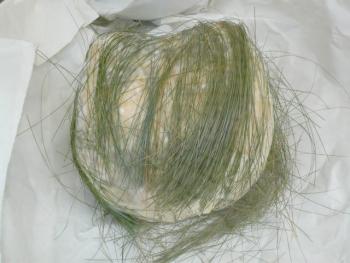Saras del fen
- Country
- Italy
- Region
- Piedmont
- Size
- Approx 5 ins dimater.
- Weight
- 1-2.5 lbs
- Website
- Milk
- Sheep
Cow
Goat - Classification
- Semi Soft
- Rennet
- Animal
- Rind
- Natural

Meaning "ricotta"in the local dialect of the Pinerolo region in Piedmont, Salas is produced from raw cow's milk sometimes with the addition of either goat's or sheep's milk. During the summer, cow's and goat's milk is mixed 50/50, while during the winter months cow's and sheep's milk (from the rare "frabosana" breed of sheep) are used to give the cheeses a sweetr, less intense flavor.
Cheeses are made in the high Alpine pastures of the Pellice Valley, between 1,900 - 7,200 feet, to a recipe that has been in existence for many hundreds of years. Depending on the cheesemaker, the cheeses vary slightly from place to place and season to season.
The external coat of green hay is cut from the same pastures where the animals graze and occasionally some thyme finds its way into the mix. Traditionally, the hay was introduced as a wrap to protct the cheeses from their bumpy ride down the hillside.
To make Saras del fen, whey left over from the production of "toma" cheese is used. The whey is heated to 158 F before a small quantity of milk is added - usually 10-15% of the total. The mix is then heated up to 194 F and the solids separate from the whey, rising to the surface, where they are skimmed off.
These delicate curds are lightly salted and placed in linen draining bags for 24 hours. The cheeses are then removed from their bags, salted again and wrapped in a thin coat of hay which has been carefully dried and prepared, before being matured for at least one week.
The texture of Saras is very fine and semi-soft. Although the color of the interior paste varies slightly depending on the mix of milks used, it ranges from ivory to pale yellow.
Aging for Saras del fen varies from between one week to one month. It can be eaten either fresh or more matured, both for eating or as an ingredient in cooking. Its traditional to use it as a seasoning or as a dessert served with blueberry jam or honey.



